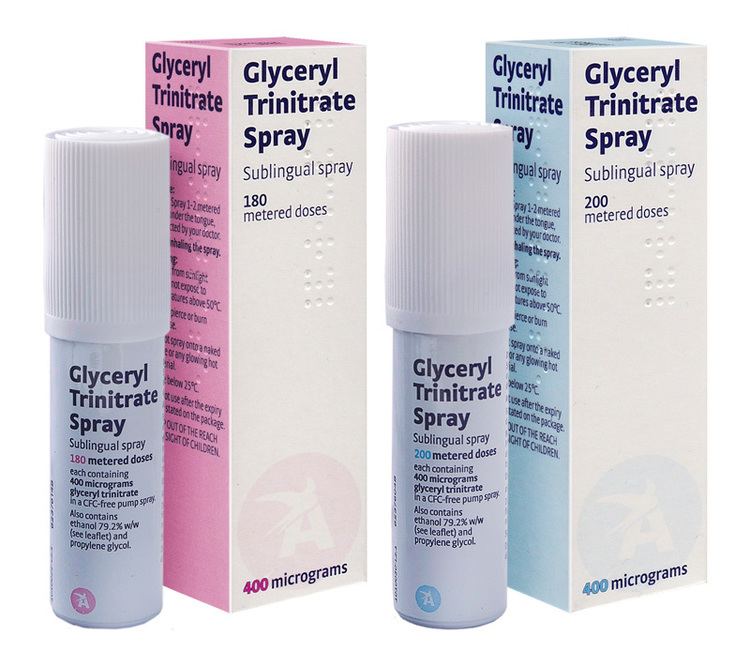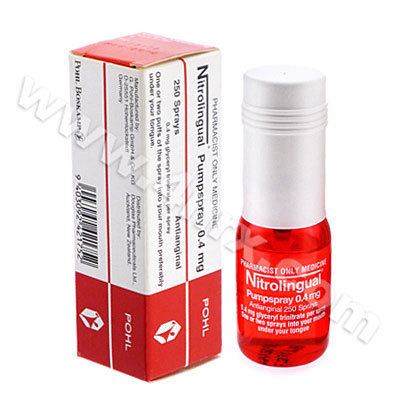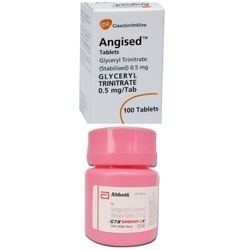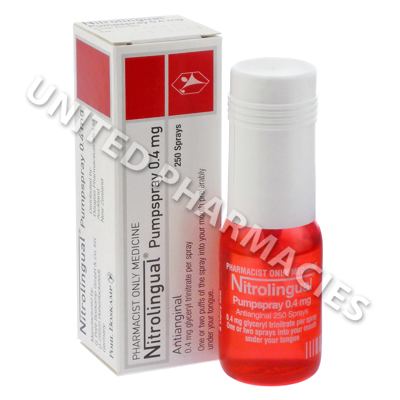Trade names Nitrol, others MedlinePlus a601086 CAS ID 55-63-0 | AHFS/Drugs.com Monograph Molar mass 227.087 g/mol | |
 | ||
Pregnancycategory US: C (Risk not ruled out) | ||
Nitroglycerin, also known as glyceryl trinitrate (GTN) is a medication used for heart failure, high blood pressure, and to treat and prevent chest pain from not enough blood flow to the heart. This includes chest pain due to cocaine and from a heart attack. It is taken by mouth, under the tongue, applied to the skin, and by injection into a vein.
Contents
- Medical uses
- Angina
- Tendinopathy
- Fissures
- Adverse effects
- Dangers
- Mechanism of action
- History
- Research
- References
Common side effects include headache and low blood pressure. The low blood pressure can be severe. It is unclear if use in pregnancy is safe for the baby. It should not be used together with medications within the sildenafil family. Nitroglycerin is in the nitrate family of medications. While it is not entirely clear how it works, it is believed to function by dilating blood vessels.

Nitroglycerin was written about as early as 1846 and came into medical use in 1878. It is on the World Health Organization's List of Essential Medicines, the most effective and safe medicines needed in a health system. The wholesale cost in the developing world for the pills that go under the tongue is about 0.06 to 0.22 USD per dose. It is the same substance as the chemical nitroglycerin used for explosives.

Medical uses
Nitroglycerin is used for the treatment of angina, acute myocardial infarction, severe hypertension, and acute coronary artery spasms.
Angina

It is useful in decreasing angina attacks, perhaps more so than reversing angina once started, by supplementing blood concentrations of NO, also called endothelium-derived relaxing factor, before the structure of NO as the responsible agent was known. This led to the development of transdermal patches of glyceryl trinitrate, providing 24-hour release. However, the effectiveness of glyceryl trinitrate is limited by development of tolerance/tachyphylaxis within 2–3 weeks of sustained use. Continuous administration and absorption (such as provided by daily pills and especially skin patches) accelerate onset of tolerance and limit the usefulness of the agent. Thus, glyceryl trinitrate works best when used only in short-term, pulse dosing. Glyceryl trinitrate is useful for acute myocardial infarction (heart attack) and pulmonary edema, again working best if used quickly, within a few minutes of symptom onset, as a pulse dose. It may also be given as a sublingual or buccal dose in the form of a tablet placed under the tongue or a spray into the mouth for the treatment of an angina attack.
Tendinopathy

Tentative evidence indicates efficacy of glyceryl trinitrate in the treatment of various tendinopathies, both in pain management and acceleration of soft tissue repair.
Fissures

Glyceryl trinitrate is also used in the treatment of anal fissures, though usually at a much lower concentration than that used for angina treatment.
Adverse effects

After long-term use for chronic conditions, tolerance may develop in a patient, reducing its effectiveness. Nitrate tolerance was first described soon after the introduction of GTN in cardiovascular therapy as the loss of symptomatic and hemodynamic effects of GTN and/or the need for higher doses of the drug to achieve the same effects. The mechanisms of nitrate tolerance have been thoroughly investigated in the last 30 years and several hypotheses have been proposed. These include:

- Impaired biotransformation of GTN to its active principle - NO (or a NO-related species)
- Neurohormonal activation, causing sympathetic activation and release of vasoconstrictors such as endothelin and angiotensin II, which counteract the vasodilation induced by GTN
- Plasma volume expansion
- The oxidative stress hypothesis (proposed by Munzel et al. in 1995)

Recent evidence suggests that the latter hypothesis might represent a unifying hypothesis, and a GTN-induced inappropriate production of oxygen free radicals might induce a number of abnormalities which include those described above. Furthermore, studies have shown that nitrate tolerance is associated with vascular abnormalities which have the potential to worsen patients' prognosis. These include endothelial and autonomic dysfunction.
In the short run, glyceryl trinitrate can cause severe headaches, necessitating analgesic (very rarely up to morphine) administration for relief of pain, severe hypotension, and, in certain cases, bradycardia. This makes some physicians nervous and should prompt caution when starting nitrate administration. The painful nature of these adverse effects has a marked negative impact on patient compliance.
GTN can cause severe hypotension, circulatory collapse, and death if used together with vasodilator drugs that are used for erectile dysfunction, such as sildenafil, tadalafil, and vardenafil.
Dangers
It is often recommended that GTN transdermal patches should be removed before defibrillation due to the risk of explosion, but careful investigations have concluded that reports of apparent GTN patch explosions during defibrillation are due to voltage breakdown involving the metal mesh in some patches.
Mechanism of action
GTN is a prodrug which must first be denitrated to produce the active metabolite nitric oxide (NO). Nitrates which undergo denitration within the body to produce NO are called nitrovasodilators and their denitration occurs via a variety of mechanisms. The mechanism by which nitrates produce NO is widely disputed. Some believe that nitrates produce NO by reacting with sulfhydryl groups, while others believe that enzymes such as glutathione S-transferases, cytochrome P450 (CYP), and xanthine oxidoreductase are the primary source of GTN bioactivation. In recent years, a great deal of evidence has been produced that supports the belief that clinically relevant denitration of GTN to produce 1,2-glyceryl dinitrate (GDN) and NO is catalysed by mitochondrial aldehyde dehydrogenase (mtALDH).
NO is a potent activator of guanylyl cyclase (GC) by heme-dependent mechanisms; this activation results in cGMP formation from guanosine triphosphate (GTP). Thus, NO increases the level of cGMP within the cell. cGMP then activates myosin light chain phosphatase via a cGMP-dependent protein kinase.
History
It was known almost from the time of its discovery by Ascanio Sobrero in 1846-7 that the tasting or close handling of nitroglycerin could cause sudden intense headaches, which indicated some form of vasodilation effect. This was reported by Sobrero. Constantine Hering developed a sublinguial dose form of nitroglycerin in 1847 and advocated for it as a treatment of a number of diseases. However, it was not known to be a specific treatment for blood pressure and chest pain.
Following Thomas Brunton's discovery that amyl nitrite could be used to treat chest pain, William Murrell experimented with the use of nitroglycerin to alleviate angina pectoris and reduce blood pressure, and proved that the headaches occurred due to overdose. He began treating patients with small doses in 1878, and the substance was soon adopted into widespread use after he published his results in The Lancet in 1879. The medical establishment used the name "glyceryl trinitrate" or "trinitrin" to avoid alarming patients, who knew that nitroglycerin was explosive.
Research
A 2007 medical development includes a small amount of nitroglycerin (trademark as Zanifil Gel) in the tip of a new Durex condom to stimulate erection during intercourse. The manufacturer says "The CSD500 condom contains a chemical in its teat, called glyceryl trinitrate (GTN), which is absorbed by the skin and causes blood vessels to dilate." Jokes were made about dynamite, and the company standing proud. The reasoning behind this research is to reduce the incidence of erection loss when men put on a condom, which is one reason for the unpopularity of condoms.
